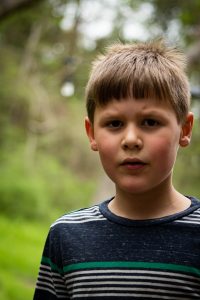Development in Middle Childhood
Learning Objectives:
- Explore and connect Psychosocial, Cognitive, and Psychosexual Development
- Explore and connect another Theory, Approach, or Perspective to work in critical thinking skills for client assessments
- Exploring important aspects of a person’s experience and ability to justify why they are important
Vignette

Monty is an 8 y/o boy living with his mother, Foley, and maternal grandmother, Livia, in a small 2 bedroom apartment in the city. Foley was 15 when she had Monty and did not finish high school. Both she and her mother Livia work different shifts at a factory nearby their apartment so one of them can be home to provide care for Monty. Monty has never met his father and knows little about him. Recently Foley has been fighting more with her mother about how Livia is becoming less patient with Monty and has begun locking him in his room when he is being disruptive.
Monty has done fairly well in school until this past year. He has always been a high energy child but had been able to respond to his teachers majority of the time when redirected. Over the past several weeks Monty has demonstrated increased struggles with defiance, aggression, and fighting with his peers. Foley has been called to meet with the school Social Worker to discuss these concerns.
Foley meets with the school Social Worker next and reports how Monty has always been a very active and impulsive child, not paying much attention to his surroundings or personal space of others. Foley describes Monty as “the Energizer bunny – he never stops, always running around, crashing into things and making a mess wherever he goes. I have a hard time getting him to listen too, and I usually end up spanking him to make him stop. My mom also spanks him, but she says it doesn’t always work so she started locking him in his room until he stops – we’ve been fighting more recently about this and I noticed he seems to be having a harder time too”. She shares some of their history with the Social Worker, such as being a teenage mother, Monty’s father never being around, and increasing struggles with her mother’s punishments for Monty, mainly locking him in his room. The Social Worker explored Foley’s thoughts on connecting Monty to mental health service as a support which could be provided at school. Foley reports feeling some anxiety with this as she does not know much about mental health services and fears Monty will simply be medicated “like a Zombie”. The Social Worker assures Foley this will not be the case as the focus will be how to support Monty with emotional and behavioral interventions, and if medication was something recommended, they would be able to discuss benefits vs possible side effects with Foley having the final say in the decision. Foley agrees to “give it a try, couldn’t hurt anything, could it?”.
Critical Thinking:
- What stage of Piaget’s Theory of Cognitive Development is the client currently in? Are they meeting expectations of this stage? Examples? Are they demonstrating any delays in this stage? Examples?
- What stage of Erikson’s Theory of Psychosocial Development are they currently in? Are they meeting the goals of this stage? Examples? Are they demonstrating any struggles with their goals in this stage? Examples?
- What theory, approach, or perspective from previous Dimensions (PIE, Biopsychosocial, Sociocultural, or Social Change) would you use to assess this client? Why?
- What do you feel are the most important aspects (physical development, attachment, sexual development, etc) to consider for this client? Why?
References
Hutchinson, E. D. (2019). Dimensions of human behavior (Sixth edition). Sage Publications, Inc.

